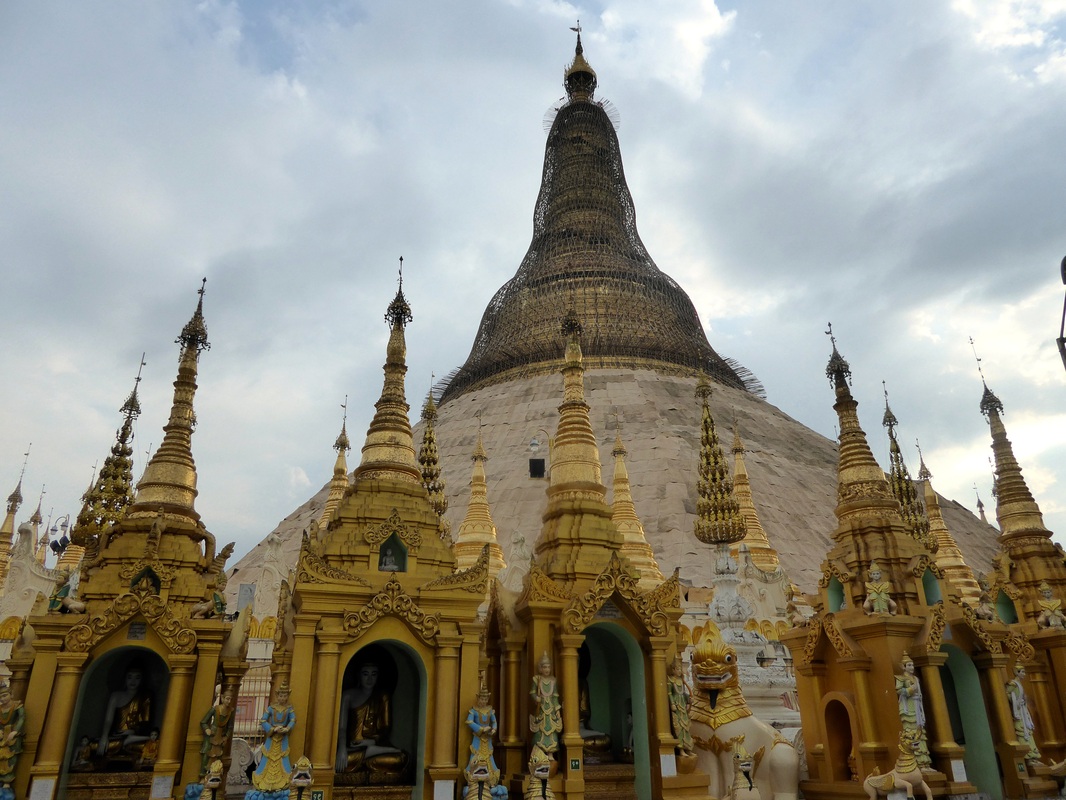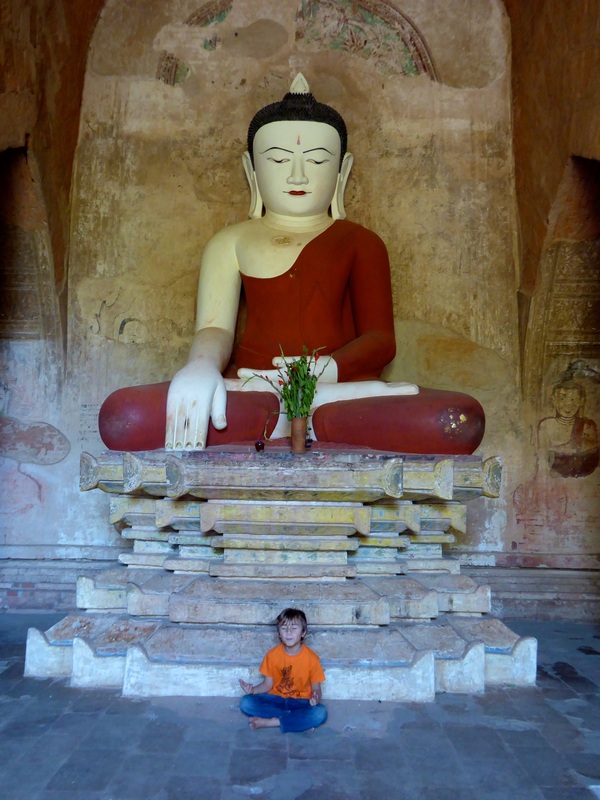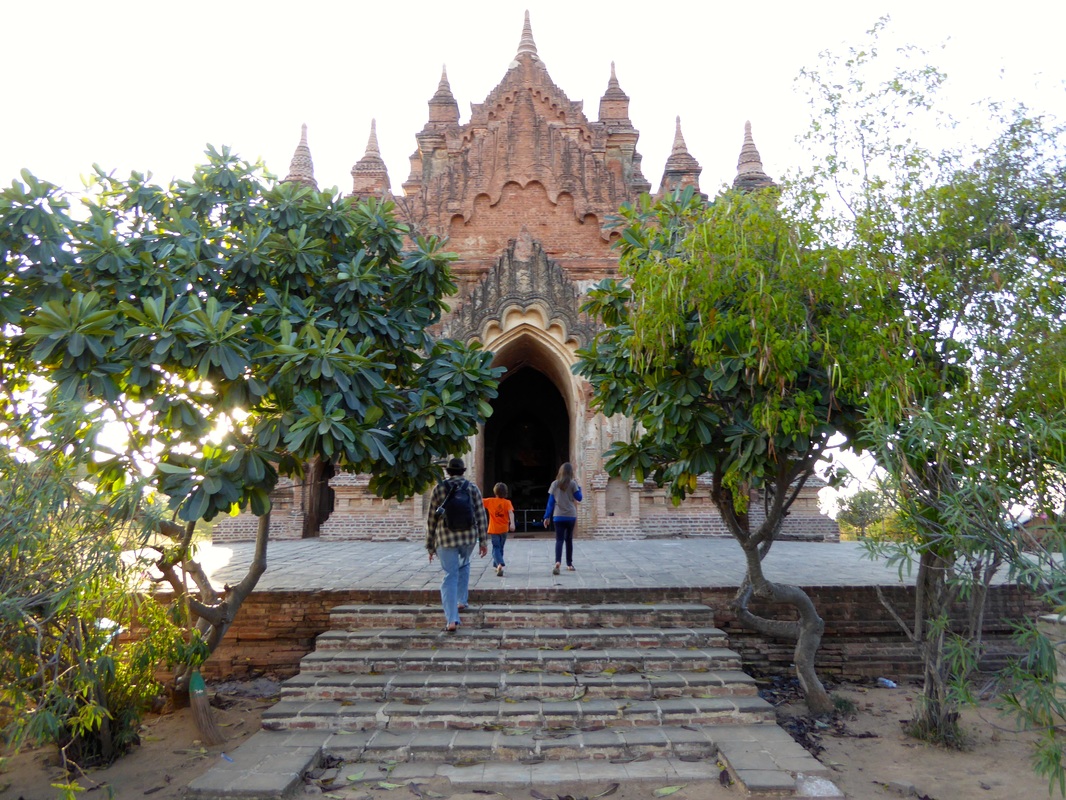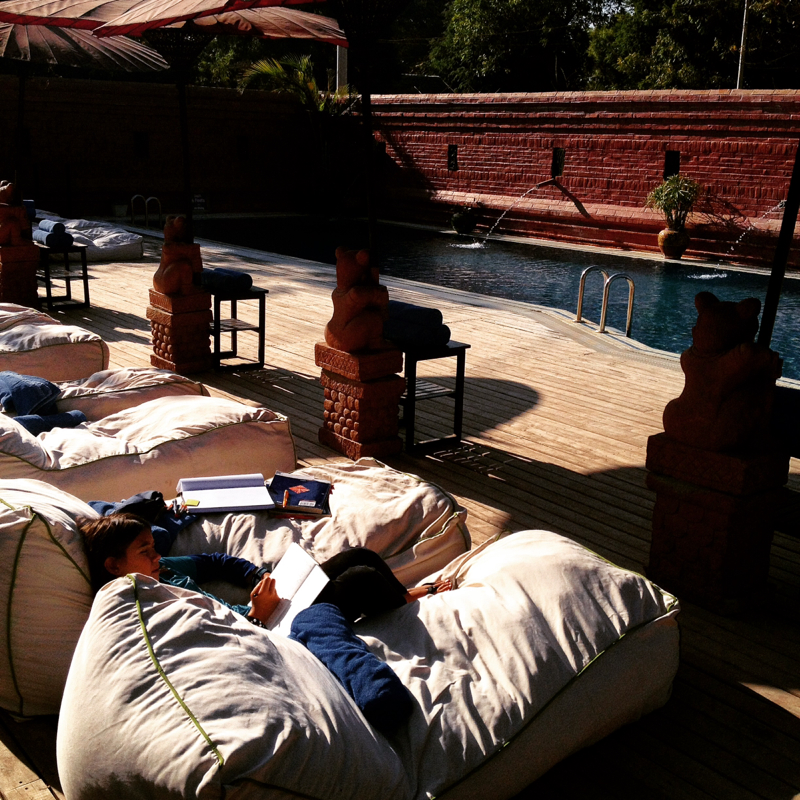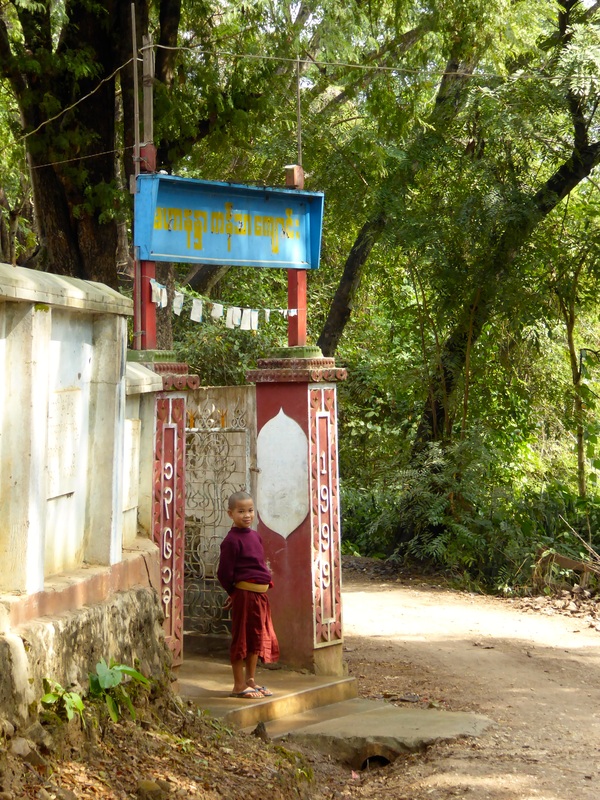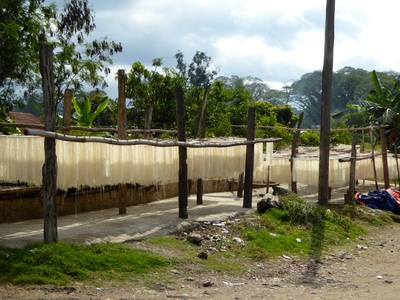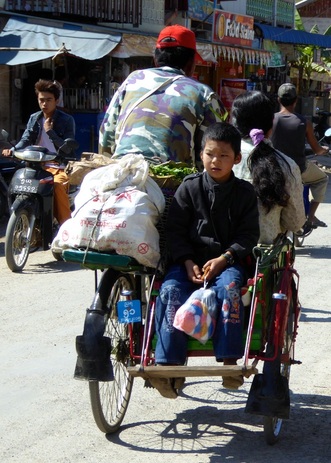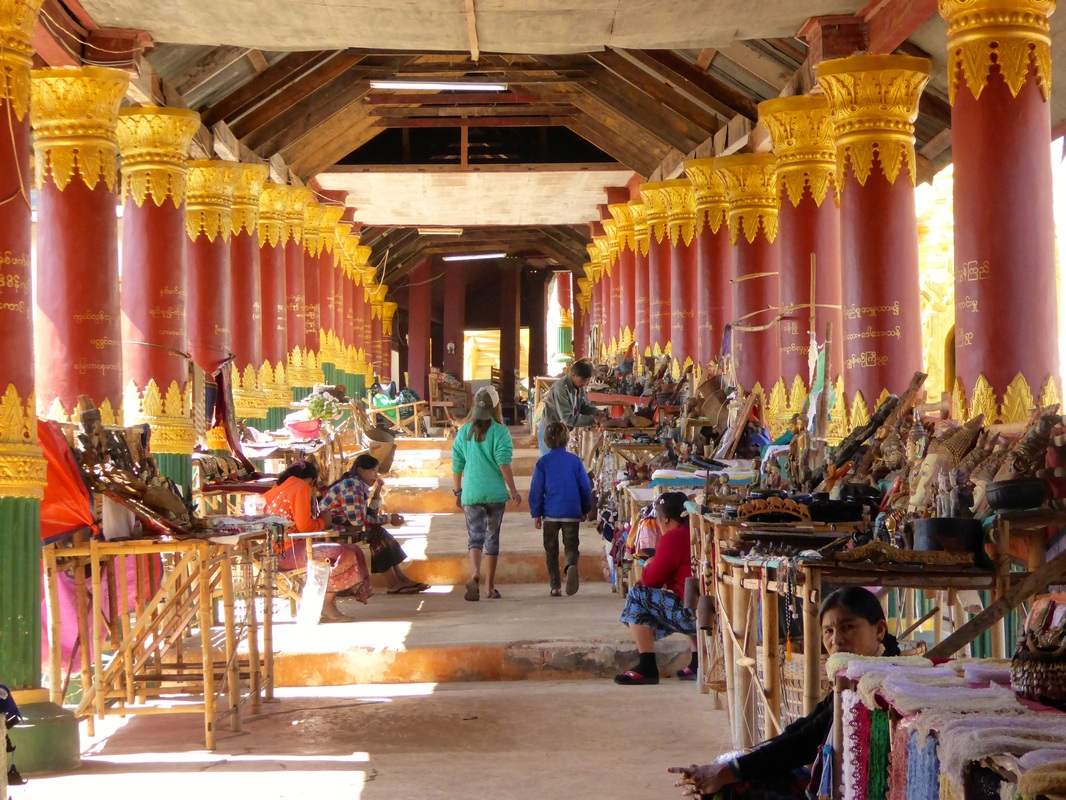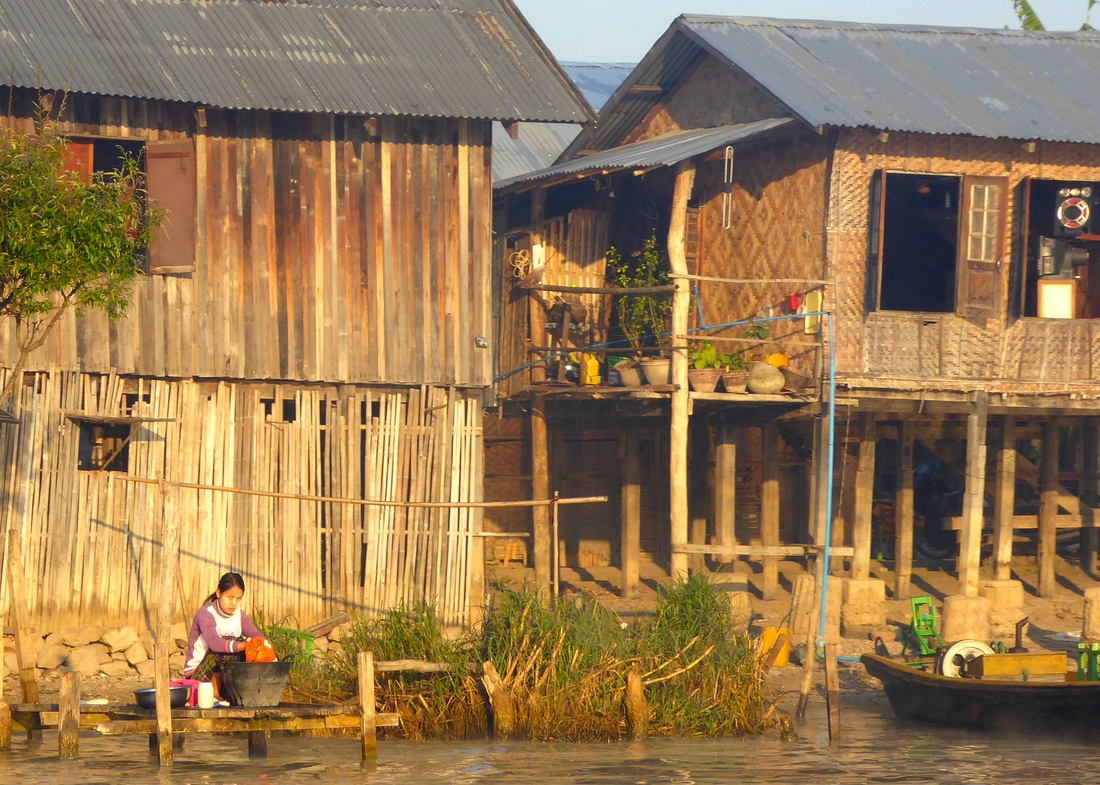Our flexibility was rewarded. Stories of a land reminiscent of Thailand 30 years ago, with beauty and friendliness that even the most jaded of travelers couldn't help but be taken with, were finding us at every turn as we stood perched in Bangkok, the entryway to our open 3 month S.E. Asia leg of our journey. The common refrain was an unequivocal, "Go to Myanmar now, before it changes." It took a little research to rid myself of outdated ideas of Burma, officially changed to Myanmar in 1989, as a dangerous and inaccessible land of never-ending opium fields, with its refugees flooding into Thailand, which I still held from my previous SE Asia travel, 20 years ago. With small yet consistent positive changes in the government, and improvements with human rights, Myanmar slowly began opening to tourism in the late 1990. After much research on the internet, available at a speed in Bangkok which we hadn't experienced since Europe, and planning visa/flight logistics, Myanmar found its way onto our itinerary.
Our entry point was the city of Yangon and our first outing, a morning visit to the most important Pagoda in Myanmar, 2500 year old Shwedagon, with its tall gilded stupa. With this visit I immediately realized we had been well guided in our decision. Myanmar's maintains a strong belief in Theravada Buddhism, which is evident with the countless temples and scores of monks and nuns seen throughout the country.
Our entry point was the city of Yangon and our first outing, a morning visit to the most important Pagoda in Myanmar, 2500 year old Shwedagon, with its tall gilded stupa. With this visit I immediately realized we had been well guided in our decision. Myanmar's maintains a strong belief in Theravada Buddhism, which is evident with the countless temples and scores of monks and nuns seen throughout the country.
As we wondered through Yangon I found an undefinable beauty in the dilapidated and chaotic streets
As always we were quite happy to stumble on some street markets, which make for a quick way to familiarize oneself with a place through its food, dress, and social interactions. Constantly on the look out for new gluten free snacks, the kids were pleased with the wide choice of rice and coconut goodies, along with the wonderful selection of fresh fruits and veggies.
With our allotted 3 weeks in Myanmar, we were eager to explore more rural areas. Bagan, the land of mist covered pagodas, was "just" a 10 hr bus trip away.
It was actually shocking how real-life was every bit as incredible as the almost too-cool-to-be-real pictures I had seen during my internet planning. The temples of Bagan really look like this. It is quite striking to take in. It did occur to me while riding on that long bus, that touring thousands of temples might not thrill the kids for very long. We wisely kept the exploring to 1/2 days, and luckily the whole "Indiana Jones" feel of the place kept their imagination peaked. It helped that one day we rented little e-bikes and scooted around exploring in whatever direction any of us felt pulled. The relative lack of restrictions and the endless tunnels and stairs of the temples created a feeling of wild discovery.
Just to be safe, we took the recommendation of parents who have visited temple studded Ankor Wat (Cambodia), and booked a hotel with a pool, so that after a 1/2 day of exploring in the heat, a cool respite awaited.
To be clear, yes Myanmar is "just" opening up to tourism but that doesn't mean you have the entire place to yourselves. Here is the temple recommend for a "less crowded" sunset viewing.
But with a sunset view like this, who's complaining?
The highlight of our time in Bagan was created from a simple spontaneous connection. Yoda and Zuki had been talking for a week or so about businesses they each wanted to set up upon their return to Hawaii. Zuki had already begun hand sewing some cute little animals from socks and miscellaneous "bling" found along our travels, while Yoda was contriving a plan based on creating wooden characters, with which he had no real experience.
We happened to pop into one of the shops along Bagan's main road where a man was carving. Wood carving is an ancient art in Myanmar and is till practiced today by master wood carvers. Yoda showed an interest and before I knew it we had arranged to bring the kids back the next morning.
We happened to pop into one of the shops along Bagan's main road where a man was carving. Wood carving is an ancient art in Myanmar and is till practiced today by master wood carvers. Yoda showed an interest and before I knew it we had arranged to bring the kids back the next morning.
The following day, Nyi Phyoe, the son of Sandar, who we had met the day before, became Yoda's carving teacher. With a chunk of teak between his feet, Yoda watched his teacher, and with guidance, copied the technique on his own piece of wood.
Meanwhile, Sandar and his wife Soe, allowed Zuki to choose a buddha mask to paint herself. They sweetly showed her step by step how to paint and emboss with gold leaf paint just like they do themselves when creating masks to sell.

After hours of work, both kids had completed what will likely be their most prized souvenirs of our trip. When we went to pay, Sandar would only accept payment for the mask which Zuki had painted. After much convincing, we were able to pay a little more for the heaps of time that they had spent teaching our children. They invited the kids back for more lessons the next day and the kids were clamoring to go but I thought we had already taken up too much of their time. I told the kids "no".
The next day we stopped into the shop after dinner to let them know that Yoda loved his mask so much that he was actually sleeping with it. Soe, with a smile on her face, asked why we had't come back that day. I instantly felt her disappointment. I was flooded with the realization that I had taken an uniquely western view, believing we were "wasting their time", a concept which may not even exist in Myanmar. I now understand that they too had genuinely appreciate the unique experience that we had all shared the day before.
I have very few regrets on this trip but not letting the kids return to this wood shop for more lessons is one. Luckily the positive side of having a regret is learning from it so that a similar occurrence doesn't happen again. I have leaned my lesson.
Unfortunately, we had already pre-booked our boat trip. The next morning we had to wake at 4:30am to catch a 14hr express boat trip to Mandalay, a stepping stone on our way to the more remote town of Hsipaw, the jumping off point for hill village treks.
The next day we stopped into the shop after dinner to let them know that Yoda loved his mask so much that he was actually sleeping with it. Soe, with a smile on her face, asked why we had't come back that day. I instantly felt her disappointment. I was flooded with the realization that I had taken an uniquely western view, believing we were "wasting their time", a concept which may not even exist in Myanmar. I now understand that they too had genuinely appreciate the unique experience that we had all shared the day before.
I have very few regrets on this trip but not letting the kids return to this wood shop for more lessons is one. Luckily the positive side of having a regret is learning from it so that a similar occurrence doesn't happen again. I have leaned my lesson.
Unfortunately, we had already pre-booked our boat trip. The next morning we had to wake at 4:30am to catch a 14hr express boat trip to Mandalay, a stepping stone on our way to the more remote town of Hsipaw, the jumping off point for hill village treks.
Our river journey was a mixed bag; on one hand was the beauty, serenity, and cultural experience of the Irrawaddy river, while on the other, was sickness and flaring temperaments, (see my previous post) causing our family dynamics to be at a low. It made for a tough day.
Now what I find extremely interesting is that while Kiko and I agree that Zuki was not a big fan of the river trip at the time, she views it entirely differently now, almost 2 months later. She cheeringly compares it to Lao's Mekong river, which she has expressed interest in going on a long boat trip, and generally not acknowledging the mood of unrest of that day. This brings to mind something I find myself occasionally wondering about; I am really intrigued to see how the children view this world trip in its entirety, given the distance of time and space. In the end how will it end up settling into their memories?
Now what I find extremely interesting is that while Kiko and I agree that Zuki was not a big fan of the river trip at the time, she views it entirely differently now, almost 2 months later. She cheeringly compares it to Lao's Mekong river, which she has expressed interest in going on a long boat trip, and generally not acknowledging the mood of unrest of that day. This brings to mind something I find myself occasionally wondering about; I am really intrigued to see how the children view this world trip in its entirety, given the distance of time and space. In the end how will it end up settling into their memories?
We didn't arrive to Mandalay, the second largest city in Myanmar, until 7:30pm that night and ended up spending 2 nights in an all-out-break. We didn't even leave the no-frills hotel room beside to go for the buffet breakfast downstairs. We ordered room service for lunch and dinner. It felt hedonistic and much needed. Part of the art of family travel is realizing when you need to do something like this. Finally fully rested, we got on a bus and finished our journey to Hsipaw.
Something about Hsipaw felt right. Perhaps it was simply the small size, or the super friendly and comfortable guest house (Tai House Resort) where we stayed, or the quirky cars around town; whatever it was, I was happy we choose to visit. As luck would have it, the first few days were rainy, keeping us from going straight on a trek and allowing us time to explore around town.
Something about Hsipaw felt right. Perhaps it was simply the small size, or the super friendly and comfortable guest house (Tai House Resort) where we stayed, or the quirky cars around town; whatever it was, I was happy we choose to visit. As luck would have it, the first few days were rainy, keeping us from going straight on a trek and allowing us time to explore around town.
We filled our days with bike exploration and wandering the markets.
We biked a few times to the "noodle factory" but never got to see the noodle making in action. Rice noodles have been one of the kid's favorite foods in Asia so it was even interesting for them to see the empty factory and the endless rows of noodles drying in the sun. Wonder if they work at night?
One morning we woke up at 4am to see the morning market, where hill tribe people sell their wares. Its quite dark and an unusual experience to be up and walking through a market at that time. The most atmospheric stalls are still lit by candles. All are packed up and gone by 7am, back to the farms.
Finally the rain cleared and we embarked on a 2 day, 1 night trek, to visit both the Shan and Palaung Tribes, over-nighting in Pankam village. Both kids were recovering from some sort of traveler's belly so we agreed with the guide to have a motorbike along in case one of the kids needed a lift part way. The hike was 6 hours on a rough road/path with an elevation gain of over 2000ft. It felt great to be getting out into the more rural landscape. Never knowing what interesting sights lay ahead , easily fueled us.
The local kids were super friendly and very interested in our children. Our guide, who has been in the guiding business since the arrival of the first tourists, told us that we were only the 3rd family to visit this village. This was really great for us, as it seemed to even out the playing field; they seemed as interested in us as we were in them.
By the time we made it up to Pankam Village, Yoda was starting to look like a local.
He quickly joined a few kids his own age playing a very organized game of throw-your-slipper-at-a-balanced-stone-to-knock-it-down-and-win-the-gambled-lot-of-rubber-bands. No local language skills needed. Even after the village school teacher came by and all the kids magically scattered, Yoda continued playing solo in front of our home-stay house for hours, even after dark, with a headlamp. I was seriously questioning all the expensive toys I ever purchased for him. He didn't even have rubber bands and he still loved it.
Sunset was amazing as it always seems to be when you have the time to appreciate it.
Our accommodations were four simple yet comfortable mattresses on the floor with warm blankets and mosquito nets on the second level above the family's kitchen.
We woke early, like we always do when filled with excitement about our new surroundings, and were rewarded with a colorful show as the sky became ablaze.
But no matter how early we wake up, the locals always seem to be up before us.
We really wished we had arranged to stay 2 nights, which would have allowed us more time to simply enjoy the remote village. Some travelers are under the impression there is "nothing to do" in these small villages but just watching or actually participating in the daily life is a wonderful experience. We could have helped in the tea plantations, with building something, or cooking, and Yoda could have located some more boys to play the "slipper game." There is a lot of activity in a place like this. Next time. Our hike down was beautiful as well, full of smiling faces, inquisitive stares, and breathtaking scenery.
We returned to Hsipaw for one more night but again I had the feeling we were departing before really giving it the time it deserved. The Shan owners of our guest house were so friendly and warm, inviting us to share in their extend family's meals, helping us arrange our days, and buying our kids the local style shirts as a parting gift. But with only 5 days left before our flight back to Bangkok we still wanted to see the famous Inle Lake, which was yet another 10 hr bus ride away.
This time we opted for a night bus which was pretty non-eventful and comfortable enough to get some sleep. Luckily when we arrived at 5AM our pre-booked hotel had our room ready and even provided us with a free breakfast. Since Bagan and Inle Lake are the top tourist destination in the country, both are set up for visitors with tasty cafes serving a wide range of food, (Burmese, Thai, Indian, Western) numerous travel agencies, and the full spectrum of guest houses and hotels from which to choose. Since entering Asia we have slowly begun to enjoy these pockets of Western comforts on the so called "backpacker's trail."
This time we opted for a night bus which was pretty non-eventful and comfortable enough to get some sleep. Luckily when we arrived at 5AM our pre-booked hotel had our room ready and even provided us with a free breakfast. Since Bagan and Inle Lake are the top tourist destination in the country, both are set up for visitors with tasty cafes serving a wide range of food, (Burmese, Thai, Indian, Western) numerous travel agencies, and the full spectrum of guest houses and hotels from which to choose. Since entering Asia we have slowly begun to enjoy these pockets of Western comforts on the so called "backpacker's trail."
Even among all this, the local eateries are never too hard to find. And for those looking, glimpses of everyday life are really everywhere.
We enjoyed biking a few days through the outskirts of town and in the nearby countryside, but compared to being on the lake, all else pales in comparison. We enjoyed being on the lake so much that we went out 3 days! At a total cost of $20 for an all day trip, how could we resist? Again we were rewarded for being natural early risers, which enabled us to witness the lake shrouded in mist as it became alive with activity.
The traditional method of fishing with large wide-weave basket/nets was quite picturesque. After our second day on the lake we were sure that the few men at the entrance to the lake were posing for tourists, but we were lucky to see the real deal further in.
It was really amazing to see the fisherman paddling with their leg, a technique that is unique to Inle Lake and allows them to have both hands free to fish. They wrap their ankle and foot around the paddle and make a circular motion to steer and propel the boat, all while fishing. Even, Kiko, who grew up fishing, seemed impressed.
The boat trips offer visits to temples on the shore of the lake and stopovers at the daily markets that rotate among the different villages throughout the week. The daily markets, range from extremely touristy, with seemingly endless stalls selling all sorts of tourist trinkets, to mostly local, with hill tribe girls shopping for wares and lots of fresh foods on offer, depending on the day and site of the market.
I was completely enthralled with the views of life on the lake; the bright colors, the stilted houses, and the people fishing, washing clothes, showering, and farming all on the shores of the lake.
One time when Yoda chose to walk a slightly different path through the market, I glanced up to see where he was and I saw a friendly woman casually enfolding him.
And this picture captures what is special about Myanmar. When fellow SE Asia travelers hear that we have been to mystical Myanmar we are immediately asked, "What is it like?". Of course it is a traveler's reoccurring dilemma to attempt to adequately sum up weeks worth of experiences in a few sentences, but I think the photo above shows what is different about Myanmar. It's the guenuine friendliness and approachability of the Burmese that set the country apart for me. Everything else were bonuses.
Traveling to Myanmar?
The face of travel is changing very quickly in Myanmar so the info below may be of some help when planning your trip.
- ATMs are widespread and functional, everywhere we visited. (Yangon, Bagan, Mandalay, Hsipaw, lnle Lake)
- When exchanging cash, only brand new bills will be excepted but there are banks in Bangkok that are equipped with these if needed.
- 30 day Visas are easily obtained via the internet. When approved you will receive an email confirmation that needs to be printed and shown on arrival. Our visas were approved overnight and there was actually a human who responded to my email after I had made a mistake on one of the online applications. http://evisa.moip.gov.mm
- Local food is quite oily and pales in comparison to neighboring Thailand, but what food doesn't? When you tire of the local food all the places we visited also offered other Asian and Western foods.
- Overland travel is long (think 10+ hours) but we found it surprisingly comfortable. Actually the buses can be downright cold with the AC blaring, so bring extra layers. Some buses provided blankets! Lots of higher end tourists flew between destinations but the prices of flight seemed high.
- Although we were warned via previous travelers and on the internet of hotels completely selling out during high season (Dec-Feb) we did not find this to be the case and regret that we panicked a little and initially pre-booked the first bit of our trip. If you are particular about getting a room at a certain hotel/guest house, pre-booking would be a good idea. We used Agoda.com and booking.com a few times and got as good prices, oftentimes better than that offered at the desk of the hotel or travel agency.

